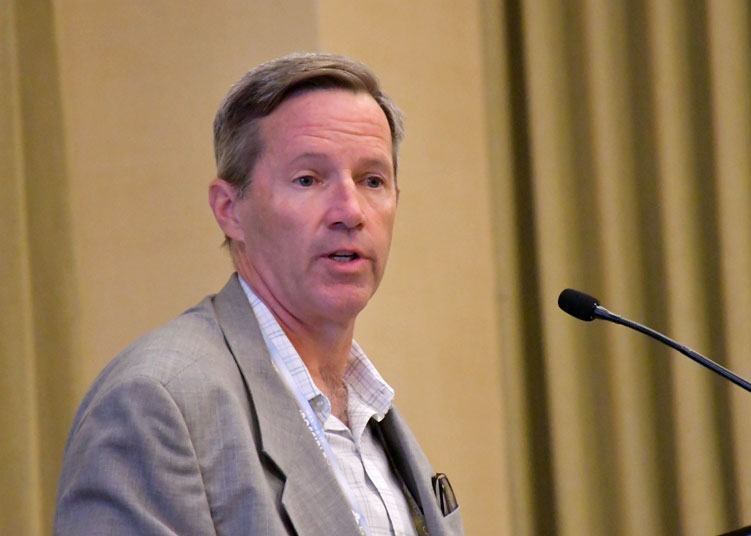State lawmakers are concerned about more domestic wells going dry in the drought and are looking for policy solutions that could give more regulatory teeth to the Sustainable Groundwater Management Act (SGMA). But a joint Assembly hearing last week showed just how far the state has come since passing the series of landmark water laws in 2014 and how complex any attempt to shorten the 20-year timeline would be.
“Should those basins that are severely overpumping their groundwater—especially in areas that are affecting people who don't have access to safe drinking water—be able to continue to grow year-round crops that are very water intensive?” asked Assemblymember Rebecca Bauer-Kahan of Orinda, the new chair of the Water, Parks and Wildlife Committee.
For Fran Pavley, a former state senator from Los Angeles who authored some of the original SGMA legislation, limiting agriculture’s use of water is a necessary next step. With drought and climate change now dominating water policy discussions since the passage of SGMA, Pavley called for slashing any “unreasonable use of water” from groundwater pumping.
“How can we stop the abuses going on that are accelerating the problems?” asked Pavley. “Should a few of those people pump all their water to the bottom?”
Pavley, who now directs environmental policy for the Schwarzenegger Institute at the University of California, Santa Barbara, sought to upend the status quo. She argued that the volume of almonds and pistachios grown in California requires an incredible amount of water, and 90% of the state’s agricultural products are sent overseas. According to the latest CDFA crop report, however, California’s agricultural exports accounted for about $22 billion out of the $50 billion in total cash receipts for all agricultural output.
 Former State Senator Fran Pavley of Los Angeles
Former State Senator Fran Pavley of Los Angeles
Pavley asked lawmakers if water should continue to be regulated as a private property right or if the state should consider it a public benefit, which would mean overhauling the water rights system. She also suggested the consequences should be stronger for groundwater sustainability agencies (GSAs) that have plans ruled incomplete.
The Department of Water Resources (DWR) has so far this year denied approval for more than two dozen groundwater sustainability plans (GSPs) spanning eight subbasins in critically overdrafted regions of the San Joaquin Valley. DWR determined that the chronic lowering of groundwater levels—potentially leading to hundreds of wells going dry—and the levels of subsidence allowed within the plans do not meet SGMA requirements.
The groundwater agencies have six months to revise and resubmit the plans before the State Water Resources Control Board enters the process as the regulatory backstop. Natalie Stork, an engineering geologist with the water board, stressed that it is not their intent to put basins on probation and that any plan the board may develop would be temporary.
“It's not meant to replace the GSP,” said Stork. “It's meant to get the basin back on track toward sustainability while GSAs fix the issues in their groundwater sustainability plans so that management of the basin can be handed back to local agencies.”
Pavley also pushed for applying Gov. Gavin Newsom’s 30x30 executive order—conserving 30% of the state’s land and coastal waters by 2030—to serve as a mechanism for allocating more groundwater to restore sensitive watersheds and wetlands along the Central Valley and Sacramento–San Joaquin Bay Delta.
Yet Roger Dickinson, a former assemblymember who was also involved with passing SGMA, called it “a little too soon” to try to consider more policy actions within the Legislature, since the Department of Water Resources is still in the early phases of reviewing plans.
DWR staff hit that point as well. Paul Gosselin, who directs the department’s Sustainable Groundwater Management Program, said GSAs have stepped up to adopt and implement plans upon submitting them and that the process is working, even for those plans deemed incomplete.
“At this early stage, SGMA is functioning well and milestones are being met,” said Gosselin, noting that even the incomplete plans have taken considerable steps toward sustainability, such as investing in groundwater recharge projects and allocation reductions to cut demand in the basin.
The department is also working with GSAs to address drought and climate change scenarios within the plans as they evolve. The discussion took place just a day after researchers concluded the West is facing the worst extended drought period in at least 1,200 years.
Dickinson cautioned the lawmakers to stay the course, particularly with funding incentives grants for on-farm water use efficiency projects through a CDFA program known as SWEEP and for a new multibenefit land repurposing program for the 500,000 to 1 million acres of productive farmland expected to go fallow under SGMA.
Asm. Cecilia Aguiar-Curry of Winters, who chairs the Local Government Committee, agreed.
“The number one thing we had to do is educate the farmers,” said the Sacramento Valley lawmaker in recollecting the initial industry responses to SGMA. “They actually came around.”
In early negotiations over SGMA legislation, farm groups dropped their opposition after lawmakers agreed the implementation would be locally led, through the creation of GSAs, and the state would play a supportive role for those agencies. At the same time, industry groups heavily backed a water bond proposal, known as Proposition 1, which voters approved in 2014, soon after then-Gov. Jerry Brown signed SGMA into law.
Delays in distributing the $2.7 billion for water storage projects have been a constant sore spot for farm groups and lawmakers in farming districts.
“I'm a little stirred right now because I am a farmer, and this looks different on the other side,” said Asm. Megan Dahle of Bieber. “If we're going to do groundwater, we need to do water storage as well.”
Dahle called for incentivizing “the good actors” and increasing enforcement for illegal marijuana grows that are “taking truckloads of water out of ag wells.”
Also disappointed with the tone of the hearing was Valerie Kincaid, a water law attorney with Paris Kincaid Wasiewski LLP, who represents several water districts in the valley.
“I don't want this committee to misunderstand,” said Kincaid. “This has been a huge effort by local agencies, and it has been largely successful.”
When California first began regulating surface water through a new permit system in 1914, lawmakers considered managing groundwater as well but assumed it would be too difficult, setting a precedent for the next 100 years until SGMA was passed, she explained. Just establishing hundreds of GSAs as new public agencies by the 2017 deadline impressed Kincaid.
Looking for the best, most comprehensive and balanced news source in agriculture? Our Agri-Pulse editors don't miss a beat! Sign up for a free month-long subscription.
She offered four issues for the policymakers to focus on, with the first being more funding for GSAs.
“These are very, very costly regulations to comply with,” said Kincaid. “DWR funding has been critical in getting through this first step. But if that dies off or if that funding dries up, we're going to be in a lot of trouble.”
Tensions have arisen between GSAs and counties over land use planning, since GSAs do not have authority over well permitting. The agencies are not water suppliers either, and SGMA does not require them to mitigate impacts to drinking water, she pointed out, adding that to do so would require a lot more funding for these agencies.
 Paul Gosselin, DWR deputy director of sustainable groundwater management
Paul Gosselin, DWR deputy director of sustainable groundwater management
Kincaid also pushed for the state to maintain local control in regulating groundwater, especially if GSAs have met the marks DWR has set out.
“That is a huge issue,” she said. “It's going to be a tension that continues to rear its head.”
Some solutions for successfully implementing SGMA are going to be more costly than others, cautioned Ellen Hanak, who directs the Water Policy Center at the Public Policy Institute of California and has studied SGMA issues extensively in the San Joaquin Valley.
“About three quarters of the [groundwater] deficit needs to be met through demand management, which basically means taking land out of production,” said Hanak. “And that's a big, hard thing.”
In reviewing the submitted plans, Hanak and her colleagues have estimated that the desire for groundwater recharge is about three times greater than the actual amount of water available for such projects, with even less opportunity during the drought.
Hanak disagreed with the notion of shortening the SGMA timelines, but acknowledged the dry conditions are forcing GSAs to “move faster on the demand side than folks were hoping.” She proposed five priorities where the state can provide support, including holding GSAs more accountable for mitigating impacts to vulnerable areas. Along with accelerating demand management, the state could work with GSAs to determine what water is available and incentivize cooperative approaches to accessing these supplies.
Gosselin similarly noted shortcomings in some basins on stakeholder engagement, and Jamie Fanous, a policy advocate for the Community Alliance with Family Farmers, went further, arguing that small-scale and underserved producers have been left out of SGMA conversations at GSAs. Fanous called for $10 million in state budget funding to support participation for these farmers. The Nature Conservancy broadened that argument, claiming the majority of GSAs are devoid of representatives from disadvantaged communities and environmental and tribal interests.
Hanak did commend GSAs in the Tule Basin for putting in place fee-based allocation systems.
“This past growing season, they already were operating on a water diet,” she said. “The front innovators on this can be really important for helping to set the tone for how you can do that and work out some of the kinks.”
While storage projects like the former Temperance Flat Reservoir proposal, the Sites Reservoir project and expanding San Luis Reservoir could be helpful, Hanak said they can lead to water that is too expensive for farmers to afford as a cost share for constructing the facilities, while the “smart economic plays” involve recharge. The money would go further, she added, by improving conveyance and other regional infrastructure.
Hanak also called farmland repurposing a good start, “but there's a lot more that the state can do to help this.”
For more news, go to www.Agri-Pulse.com.


